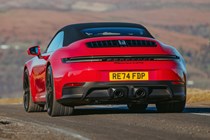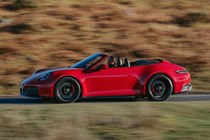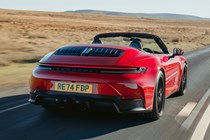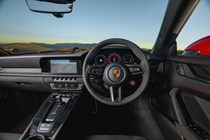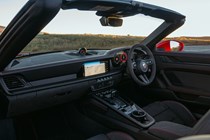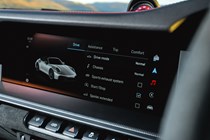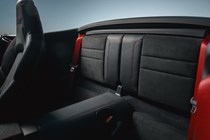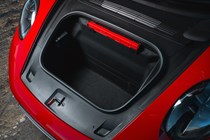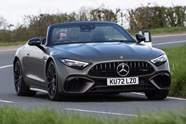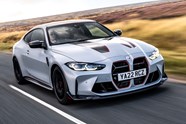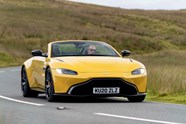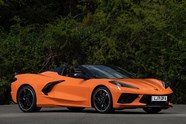
Porsche 911 Cabriolet review
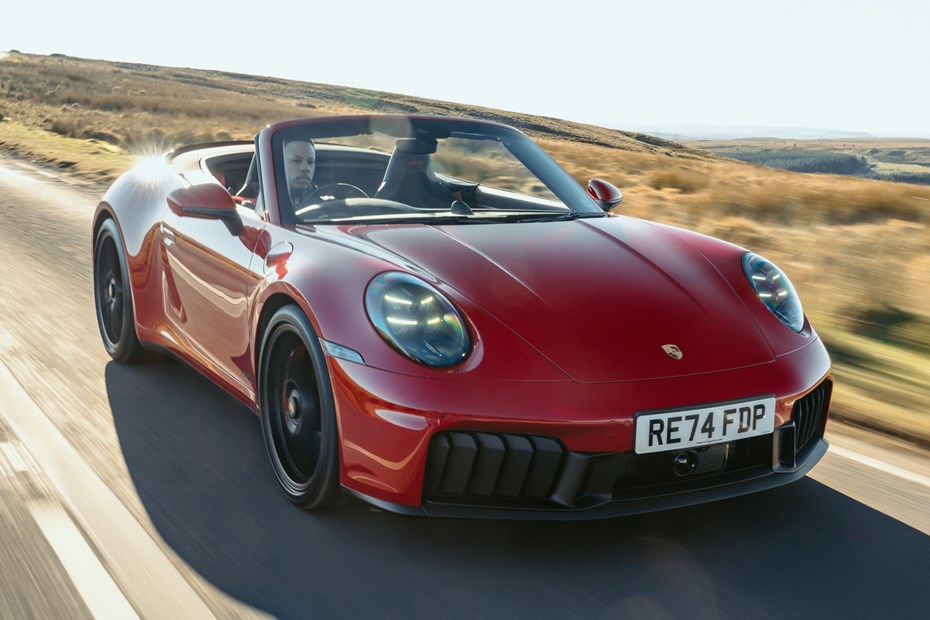
At a glance
| Price new | £118,435 - £159,135 |
|---|---|
| Used prices | £84,924 - £131,264 |
| Road tax cost | £620 |
| Insurance group | 50 |
Get an insurance quote with

|
|
| Fuel economy | 25.7 - 27.4 mpg |
| Miles per pound | 3.8 - 4.0 |
| Number of doors | 2 |
| View full specs for a specific version | |
Available fuel types
Petrol
Hybrid
Pros & cons
- Almost as good to drive as the coupe
- Hybrid power adds to the thrills
- Usable every day - for a sports car
- Tighter rear seats than the Coupe
- 4WD models more prone to understeer
- Long and expensive options list
Porsche 911 Cabriolet rivals
Overview
Hot on the tailpipes of a refreshed 992.2 generation coupe is the latest Porsche 911 Cabriolet. Like the tin-top, lightly tweaked styling subtly ushers in a new electricity-enhanced GTS hybrid and fully digital instrumentation to keep it among the best sports car out there.
Pure petrol models are retained, with the Carrera, Carrera T and Carrera S getting a revised version of the old car’s 3.0-litre twin-turbocharged flat-six rather than the GTS’s new 3.6-litre unit. Don’t worry, there’s no CVT transmission or massive increase in weight. You still get an eight-speed dual-clutch gearbox, while the small 1.9kWh battery and motors mounted in the gearbox and turbo add only 40kg.
There’s no electric-only mode, just a boost in performance and efficiency from a system derived from Porsche’s championship winning endurance racers. Total power is 541hp, 61hp more than the old GTS. Carrera and T only gain 9hp, with the S gaining a more useful 30hp.
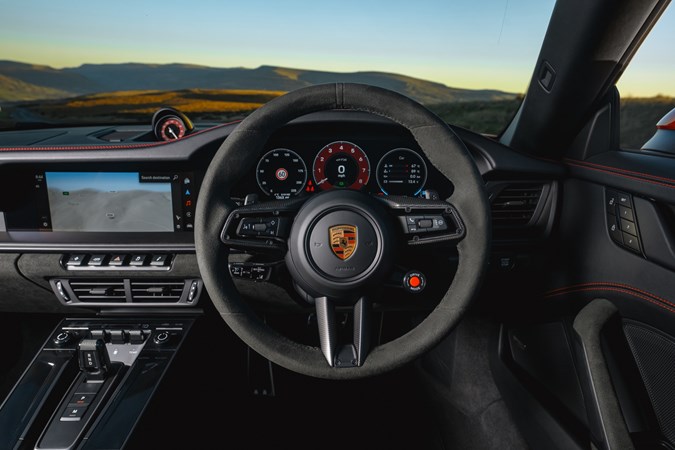
New dampers help both ride and handling, while the level of standard equipment has been increased. This has come with a hefty price hike as with the coupe. Rivals include the BMW M4, Mercedes-AMG SL, Chevrolet Corvette and Aston Martin Vantage Roadster, with the upcoming 911 Turbo able to worry full blown supercars with its savage off-the-line acceleration.
Read on for our impressions of the hybrid GTS driven in the UK, with impressions of the T coming soon. If you’re curious about how we test cars at Parkers, follow the link to our explainer page.
What’s it like inside?
Like the coupe, but with the option of a lot more headroom. As you’ll be looking at the new 12.6-inch digital driver’s display a lot, let’s start with that. It has crisp and attractive graphics and a selection of styles including sat nav front and centre, something for the track, or traditional dials. The display certainly makes the cabin feel more contemporary, and is thankfully operated by buttons and dials on the steering wheel, not touch-sensitive icons.
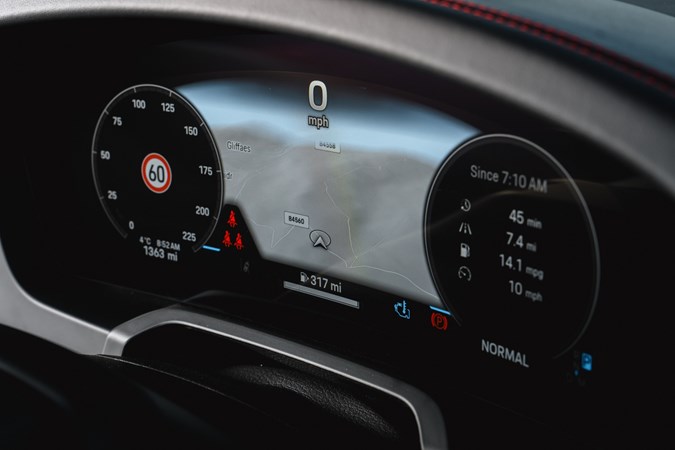
Everything else is familiar 911, with a near-perfect driving position (at least with the optional fully electric front seats), plenty of space up front and a few physical controls for key functions. This includes the heating and controls on the steering wheel, while all models now get a rotary drive mode selector on the steering wheel. Some may wish for a bit more storage given the usable nature of the 911, but I’m really nitpicking here.
It’s also worth mentioning that 911s no longer come as standard with rear seats, presumably to save a few pounds in both weight and money. Surprisingly, Porsche doesn’t charge to install them if you want the additional practicality. As ever, they’re best suited to children, shorter adults or additional baggage. Packaging the roof also means the seat backs are more upright, making the Cabriolet’s even less comfortable than the coupe’s.
What’s it like to drive?
Chopping the roof off of a car is never good for ride and handling, but the compromises are relatively small. The well-insulated soft-top opens and closes at up to 31mph and keeps noise well suppressed. Buffeting isn’t too bothersome and it’s less noisy with the roof down than the 911 Targa. The Cabriolet feels more structurally rigid than the Mercedes-AMG SL, with only the occasional tremble from the rear-view mirror giving the game away.
So far we’ve only tried the Cabriolet in GTS and T form, although we’ve had experience in the Carrera Coupe which is only slightly faster than its drop-top equivalent. All get new adaptive dampers with a greater breadth of adjustment, but the GTS still feels like it’s geared more towards handling than comfort. The damping is well-judged, never tripping up over bumpy roads, with Sports mode bringing a bit more control and sharpness. Go any firmer on the suspension and it’s a bit much for a B road.
The Carrera T Cabriolet swaps out Porsche’s PDK automatic gearbox for a six-speed manual instead. It’s a sumptuously notchy and mechanical gearbox, but you have to work to get the best out of it. The car we tested was a left-hand drive model, and back-to-frontery of the seating position aside, yanking on the wood-trimmed gear-knob still required a real positive action to shift from one gear to the next. It struck us as a manual you could probably learn to adore rather quickly, but one you’d need to get to know first.
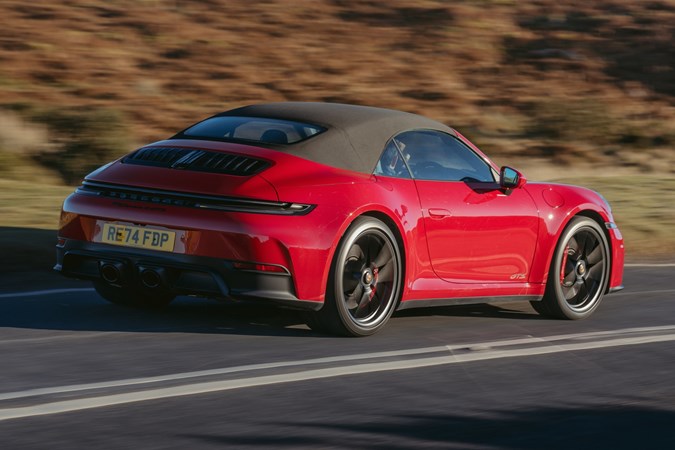
As with the coupe, I’d expect a base Carrera to feel plenty quick enough for most, taking just over four seconds to get from 0-62mph. The GTS knocks a second off this time and feels even more responsive to throttle inputs. It’s one of the best integrated hybrid systems I’ve experienced, and gives the GTS a more distinct, ferocious character compared with the old car.
I know from the coupe the base Carrera engine has plenty of low down muscle but is still happy to rev, making a great noise in the process, with the GTS feeling sharper and more like the naturally aspirated engine you get in a GT3. You can’t have a manual Carrera or GTS, just the quick-witted eight-speed auto with paddle shifters that give faithful manual control. We’ll be driving the manual-only Carrera T soon.
Four-wheel steering boosts agility on many models including the GTS, but there’s a lot to be said for the purity and predictability of the Carrera’s front-wheel steer. Both have plenty of feel, feedback and precision, as do the excellent brakes. The heavy rear weight bias gives fantastic traction out of tight bends and an occasional sense of lightness over the front axle for that classic 911 feel.
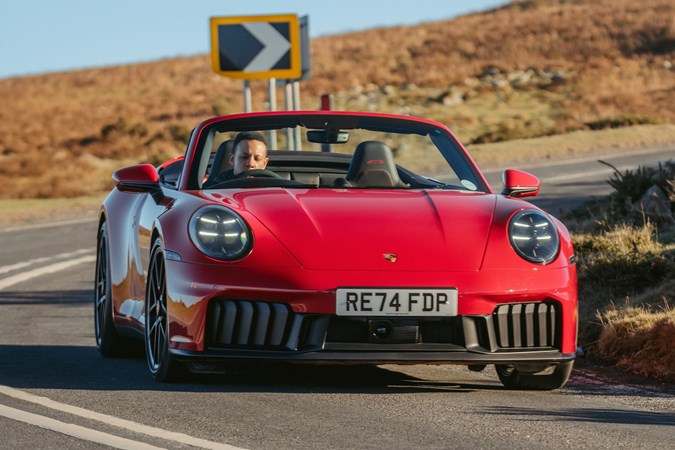
I did find the front end keen to wash wide in the four-wheel drive GTS Cabriolet in lower-speed constant throttle cornering. Near-freezing conditions won’t have helped – the GTS was at times spinning all four tyres whilst accelerating on the move – but it felt too keen to send power to the front tyres. More liberal use of the right pedal in the sportier settings offsets it.
What models and trims are available?
The 992.2 kicked off with the base Carrera and sportier GTS, with the driver-focused T and familiar S sitting above it but below the GTS. Expect a ridiculously fast 911 Turbo and Turbo S in due course. You get more equipment as standard on all models which does explain some of the price hike across the range.
Adaptive LED headlights, lane keep assist, traffic sign recognition, brake assist, parking sensors and a rear-view camera take some of the strain off you, while the heated front seats and steering wheel are most welcome during a UK winter. Going up a model doesn’t guarantee a great deal more luxury, so budget for a five-figure options spend if you’re doing it properly.
The new front bumper retains the horizontally split front intakes rather than the vertical ones of the hybrid GTS, there’s a new back bumper and new wheel choices including Taycan-style aero-optimised ones.




